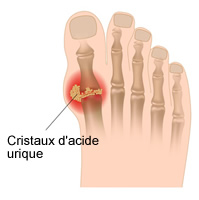Uric acid is the final stage of the breakdown of purines which come from food (a small part), cell purinosynthèse, the nucleic acid catabolism (mostly).
He was removed to two thirds in the urine.
Indications:
• Find a primary or secondary gout.
• Monitoring of a patient with chronic renal failure.
• Monitoring of pregnant women with hypertension.
 Sample:
Sample:
The uric acid increased after meals, alcoholic excesses and physical exertion must be taken from a patient fasting and rest.
Collection of blood on dry or heparin tube (no oxalate or fluoride that disrupt determinations).
If the patient is treated by infusion of urate oxidase (to prevent acute renal failure in intensive chemotherapy) immediately send the sample to the laboratory in ice ..
Typical values:
• Man:
40 to 60 mg / L (240-360 micromol / L)
• Women:
30 to 50 mg / L (180 to 300 mmol / L)
• Child:
25 to 40 mg / L (150 to 240 mmol / L)
Conversion Factors
mg × 5 = 95 micromol
ĩmol × 0.168 = mg
Interpretation:
Hyperuricemia> 70 mg / L (416 mmol / L):
Secondary hyperuricemia:
Secondary rarely symptomatic hyperuricemia may be due to:
• to increase the production of uric acid:
– Following a massive consumption of beer,
– During tumor lysis caused by chemotherapy of hematological malignancies;
• to decreased renal excretion of uric acid:
– Chronic renal failure (treat it if it exceeds 600 mmol / L)
– Treatment with pyrazinamide (Pirilène)
– Pre-eclampsia (an increase of serum uric acid above 330 mmol / L [60 mg / L] is one of the first signs of toxemia).
Primary hyperuricemia, gout:
Most hyperuricemia are primary, and are a sign of a drop.
In this disease tissue deposition of urate cause acute microcrystalline arthritis, the most characteristic is that of the metatarsophalangeal joint of the big toe.
Gout:
Gout is a man’s disease (90% of cases) between 30 and 50 years old, made of gouty attacks the lower limbs, urate deposits under the skin (tophi) or in the joints (gouty arthropathy). It carries a risk of urolithiasis.
Serum urate levels> 420 mmol / L (70 mg / L) is almost constant in gout, provided repeat testing because of fluctuations are frequent and gouty attacks may be accompanied by a transient decrease in serum uric acid.
Exceptionally, gout occurs in genetic diseases such as Lesch-Nyhan syndrome, which combines hyperuricemia, urate lithiasis early, psychomotor retardation, extrapyramidal disorder and self-mutilation.
Hypouricemia <25 mg / L (150 mmol / L):
The hypouricemia has no clinical significance, but it is a sign that can help identify an unknown condition jusquelà.
The hypouricemia has three causes:
• a medication inhibiting the synthesis of uric acid (allopurinol) and increasing its clearance (phenylbutazone).
This is by far the most frequent cases;
• a reduction in the synthesis of uric acid:
– Severe hepatic impairment,
– Very rare hereditary deficiency of xanthine oxidase;
• an increase in the urinary excretion of uric acid (see urinary uric acid):
– Idiopathic,
– Or caused by a tubulopathy.

You must be logged in to post a comment.